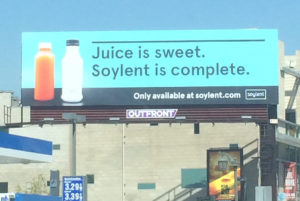
Two experiences this week inspired this blog post. The first occurred when I passed a billboard for Soylent while driving through Hollywood. The billboard read, “Juice is sweet; Soylent is complete.” My initial thought was that consuming Soylent would just be depressing.
Soylent is a “nutritionally complete, ready-to-drink, meal in a bottle” developed by engineers. Its main ingredients are oat flour and maltodextrin and a mix of vitamins, minerals, protein, and carbohydrates. Soylent creator Rob Rhinehart was working at a tech startup and began to resent the physical requirement of eating, “Food was such a large burden,” he told a reporter at The New Yorker. It was also expensive. He developed Soylent to save time and money. In interviews he said he was not interested in creating something tasty, only something efficient and nutritious.
A New York Times reporter who tried it said it was “a punishingly boring, joyless product.” I have read about Soylent but never tried it. When I passed the billboard my thought was that Soylent was bottled sadness; food lacking any variety in taste and texture. In other words: food without any of the good parts!
This image the billboard conjures contrasts sharply with the experience of food as depicted in the movie City of Gold, which I viewed only a few days later. This documentary, about Los Angeles-based Pulitzer Prize-winning food writer Jonathan Gold, is a celebration of food, Los Angeles, and ethnic diversity. (I highly recommend it, by the way!).
In the movie, Los Angeles is described as a crossroads where people of many different ethnicities have settled and brought their unique cuisines. Immigrants to LA developed food stands and inexpensive restaurants to serve the palates of their own ethnic communities. These were not restaurants designed to serve the assimilated American majority – they were part of the daily life of the immigrants. There are Korean restaurants, Mexican restaurants, and Chinese restaurants in abundance. Jonathan Gold, unlike many food critics, writes about these strip mall burrito and hotdog stands; as others have described, “democratizing” food. It further shows how the collision of ethnicities in Los Angeles brings these tastes and traditions to broader groups and creates crossovers such as Korean tacos, the iconic Korean-Mexican fusion which originated in Los Angeles as street food.
Juxtaposing City of Gold with the Soylent billboard, I wondered how anyone in Los Angeles would choose Soylent over the real food traditions described in the movie. Food expresses culture and offers the opportunity for connection. By eating Soylent, something artificial and without heritage, one is opting out of a greater connection to others and to life. The idea of consuming the same food day after day when there are so many different cuisines to sample – that is what depressed me. And, of course, I thought about my work.
One of my favorite aspects of working as an eating disorder professional is helping clients recover from devastating illnesses that make them fear and avoid food – the very sustenance they need to survive – and progress to a place where they can rediscover the joys of food. Jonathan Gold is a great role model for the love of food and positive engagement with the world. My hope for my patients is that they will get to a similar place where they embrace the varieties of food available and open themselves to experience culture in this way.